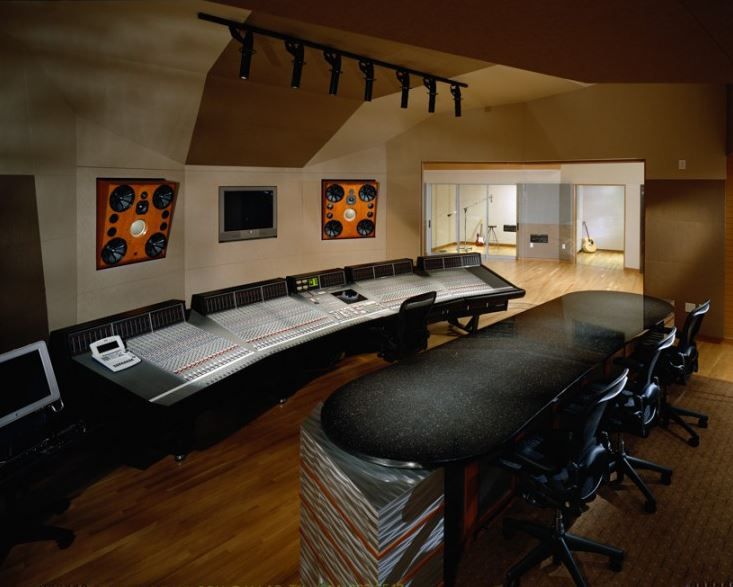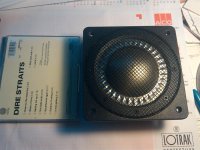using an CD without an horn is like driving a car without wheel
Yep, and it's called a flying car. 😎
An externally hosted image should be here but it was not working when we last tested it.
Let's be serious here folks. Running a compression driver without a horn does what? Sure, the driver design expects a certain lower impedance load, as the horn is fundamentally an acoustic transformer, right? What happens when the horn is not there toward the bottom of the pass band? (others have noted that it Is still there for the highest frequencies, due to throat geometry, especially for threaded drivers). But, there is still the matter of compression ratio via phase plug configuration. Wouldn't this maintain some increased efficiency (and loading) across some band of frequencies even without a horn? I don't know. It's been too long since I read the books.
Also, what about diffraction?
Also, what about diffraction?
Last edited:
I don't think you get any increased efficiency without a horn expansion. The threaded throat of a horn is basically a straight pipe. There would be some expansion inside the body of the driver (bolt-on or threaded) but what would you compare the efficiency to?
Ridiculous. I've measured a few drivers with out a horn and what you get is about an octave of treble and the rest is way down. When you eq it you lose around 25 db from the peak to 400 cycles. So in reality the distortion at 400 cycles is up 25 db and the sensitivity goes down to a typical dome midrange. I said I was out of this thread but here I am LOL - it just so ridiculous 🙂
Here is a Japanese DIY'er using naked CDs with back cover removed:
ƒhƒ‰ƒCƒo�[[/QUOTE]
JBL made a system with this configuration, not sure if it was just experimental.
[url=http://www.lansingheritage.org/html/jbl/specs/home-speakers/1988-cascade.htm]1988 CASCADE[/url]
Ridiculous. I've measured a few drivers with out a horn and what you get is about an octave of treble and the rest is way down. When you eq it you lose around 25 db from the peak to 400 cycles. So in reality the distortion at 400 cycles is up 25 db and the sensitivity goes down to a typical dome midrange. I said I was out of this thread but here I am LOL - it just so ridiculous 🙂
WELCOME BACK, POOH!

'was not the same without you... So, how will be your christmas ? 😛
Pooh, you're probably right, man. I'm hallucinating sounds from the very start. In fact, the midrange was comin' from the neighbor's Bose system!
BOSE: BETTER SOUND THROUGH RESEARCH
you're damn right, better sound even through *&%? walls!
hahaha
BOSE: BETTER SOUND THROUGH RESEARCH
you're damn right, better sound even through *&%? walls!
hahaha
i have demonstration of the opposite.
Sensitity is the highest i tested so far, the bandwith is surprisingly wide and the radiation is the big bonus of the hornless.
You're 0 out of 3
I'm not seeing it ?!
Can you post the chart of the sensitivity, and a chart of the angular dispersion?
Let's be serious here folks. Running a compression driver without a horn does what?
You'd expect poor sensitivity and completely useless polar pattern. Jon says otherwise so let's see the chart, and we can all be on the same page then, for understanding what this is about. Thanks Jon.
You'd expect poor sensitivity and completely useless polar pattern. Jon says otherwise so let's see the chart, and we can all be on the same page then, for understanding what this is about. Thanks Jon.
Cmon guys let it go
Nothing is useless if the user finds it useful
You can request info and data but be polite about it. Prefacing with words like "poor" and "useless" probably wouldn't get me jumping out of my seat in a hurry to get measurements for you...
Why did you use a PB950 with Beryllium diaphragm ? does it make a difference up to 3,5khz ? I don't remember if i tested it without horns, but with horns there was always coloration.
Why did you use a PB950 with Beryllium diaphragm ? does it make a difference up to 3,5khz ? I don't remember if i tested it without horns, but with horns there was always coloration.
No reason other than i had them.
I'm planning to use the standard aluminum version, but i'll compare side to side before making the decision.
I wonder, though, if their ability to perform so well crossed so low -and hornless- has something to do with the Truextent diaphragm's suspension, which is to my understanding not exactly the same as the standard one from Radian.
JBL 095Ti are not a repurposed compression driver, but a regular 3" dome midrange.
The diafragm migth look like that of a compression driver, but the magnet system are more like the one you will find in a Vifa D76MX, Dynaudio 3" or even a Tangband 3" dome.
The Cascade did not Reach Production as far as i know, but the 095Ti did surface in the JBL XPL series and also as a car audio driver called T030
Attachments
Last edited:
Ed Long's CRM series studio monitors in the 80s-90s used a compression driver without horn as a tweeter. These were in pretty widespread use and chances are, if you have a sizeable music collection, that something in your collection was tracked and/or mixed on these. There are still quite a few in use. There are some photos in this "for sale" ad I found:
https://reverb.com/item/1004367-e-m-long-crm-1ta-time-align-custom-studio-monitor-dual-18-jbl-2245
Ed was a pioneer in time alignment (he owns the trademark for "Time Align" but has never enforced it), near field monitoring, ELF low frequency alignment method, and pressure zone microphones. He certainly knows what he is doing.
If I recall, he did use the faceplate he designed for the driver to somehow provide some loading for the driver. I posted this to show that a properly chosen compression driver can be used effectively without a horn.
This doesn't mean I'm actively promoting the practice. It was done in this case because high quality, high output direct radiating high frequency drivers suitable for studio monitoring use were not readily available. That is not the case any longer. That particular toolbox has become plentiful (and speaker designers, DIY and Pro, are grateful for that!).
The same can actually be said for the ELF low frequency section. Now that long-throw, low distortion, woofers and subwoofer drivers are available, the need for ELF is not really there. But, at the time it was a revelation compared to the PA derived vented cabinets that were commonly used for low frequencies in recording studios.
https://reverb.com/item/1004367-e-m-long-crm-1ta-time-align-custom-studio-monitor-dual-18-jbl-2245
Ed was a pioneer in time alignment (he owns the trademark for "Time Align" but has never enforced it), near field monitoring, ELF low frequency alignment method, and pressure zone microphones. He certainly knows what he is doing.
If I recall, he did use the faceplate he designed for the driver to somehow provide some loading for the driver. I posted this to show that a properly chosen compression driver can be used effectively without a horn.
This doesn't mean I'm actively promoting the practice. It was done in this case because high quality, high output direct radiating high frequency drivers suitable for studio monitoring use were not readily available. That is not the case any longer. That particular toolbox has become plentiful (and speaker designers, DIY and Pro, are grateful for that!).
The same can actually be said for the ELF low frequency section. Now that long-throw, low distortion, woofers and subwoofer drivers are available, the need for ELF is not really there. But, at the time it was a revelation compared to the PA derived vented cabinets that were commonly used for low frequencies in recording studios.
I forgot about this one: Quested HM412 and HM415 main monitors used to use a Community Sound compression driver for the low-mid (the big white domes in the photo). The pair below were at Patchwerk Studios, in Atlanta:

These are still made, but are using a more conventional cone driver these days. the "HM" in model designation stands for "Hooligan Monitor". They are for facilities that demand stupid high output from their monitors. (No doubt contributing to the hearing loss of any engineers who regularly used them at those levels.) 😡

These are still made, but are using a more conventional cone driver these days. the "HM" in model designation stands for "Hooligan Monitor". They are for facilities that demand stupid high output from their monitors. (No doubt contributing to the hearing loss of any engineers who regularly used them at those levels.) 😡
Last edited:
Jon,I wonder, though, if their ability to perform so well crossed so low -and hornless- has something to do with the Truextent diaphragm's suspension, which is to my understanding not exactly the same as the standard one from Radian.
I have listened to dozens of drivers "hornless", some with half round surround, some with diamond shapes, and others that are a bit too hard to describe- they all sound good, though the older "snout" style drivers are beamy at the top end due to the "built in" horn.
Listening to the drivers with the diaphragm used as a dome radiator, the horns side stuffed with rags is also "interesting".
Art
The image you see above are the very speakers i'm having for the last 10 years, which were built specifically for the well-known ATC domes (SM75-150). I probably listened to them 10,000 hours if not more... I can tell you this: they are not the same animals as these 950PBbe hornless. Not even close.
How can i describe what i'm hearing now ? Well, imagine the openness of the ATC, but with much more resolution and dynamics, but still smooth, not annoying.
Interesting, the SM75-150 is the closest I have heard to matching the midrange transparency of my rebuilt ESL57. I was thinking about switching out the dome tweeter with a waveguide RAAL to narrow the pattern at the crossover.
- Home
- Loudspeakers
- Multi-Way
- The Official HORNLESS Compression Driver Thread
